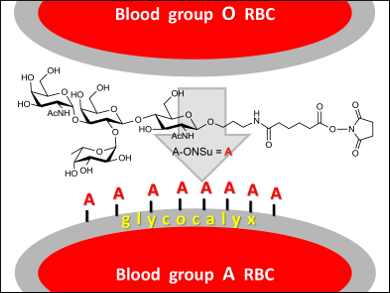The exact mechanistic details of the agglutination (clumping) of red blood cells with antibodies have not been fully studied. This is true despite the fact that agglutination is the most practical method for routine blood group typing. Whilst more modern analytical techniques are available and are well suited to typing large numbers of blood samples or organ donors, agglutination remains the standard method in routine use for patients who require a blood transfusion.
Nicolai Bovin, Shemyakin–Ovchinnikov Institute of Bioorganic Chemistry, Russian Academy of Sciences, Moscow, and colleagues have studied one aspect of agglutination using chemical biology. The team modified red blood cells of the blood group O with a chemically synthesized mimic of the human blood group A antigen at two different sites: one at the periphery of the glycocalyx and one in the middle of the glycocalyx. The glycocalyx is a glycoprotein- and glycolipid covering that surrounds the cell membrane (pictured in grey). Using this approach, the team was able to demonstrate different amounts of agglutination with a standard A antibody at the different sites.
The peripheral labeling with A antigen produced similar agglutination scores to human red blood cells of blood type A. The insertion to the middle of the glycocalyx produced lower agglutination scores, proving that the location and accessibility of antigens are critical to the agglutination by specific antibodies. According to the researchers, this approach could be helpful for other assays which require a site-specific, non-invasive modification of cells with ligands.
- Blood Group O→A Transformation by Chemical Ligation of Erythrocytes,
Ivan Ryzhov, Alexander Tuzikov, Holly Perry, Elena Korchagina, Nicolai Bovin,
ChemBioChem 2018.
https://doi.org/10.1002/cbic.201800289




